Courier, Express, and Parcel Services Market Overview
The global Courier, Express, and Parcel (CEP) services market is expanding rapidly, fuelled by e-commerce growth, increasing demand for fast and reliable delivery services, and technological advancements in logistics. This dynamic market is influenced by consumer expectations for quick, cost-effective, and transparent delivery services. The sector is increasingly adopting digital technologies to optimize logistics, improve customer experience, and manage operational efficiency. Procurement in this space focuses on improving supplier relationships, optimizing fleet management, and leveraging data analytics to predict demand and optimize service routes. The demand for CEP services is poised to grow through 2032, driven by the evolution of e-commerce, international trade, and changing consumer behaviours.
The outlook for the Courier, Express, and Parcel services market is promising, with several key trends and projections indicating significant growth:
- Market Size: The global CEP market is expected to reach approximately USD 530 billion by 2032, reflecting a compound annual growth rate (CAGR) of around 7.5% from 2024 to 2032.
Growth Rate: 7.5%
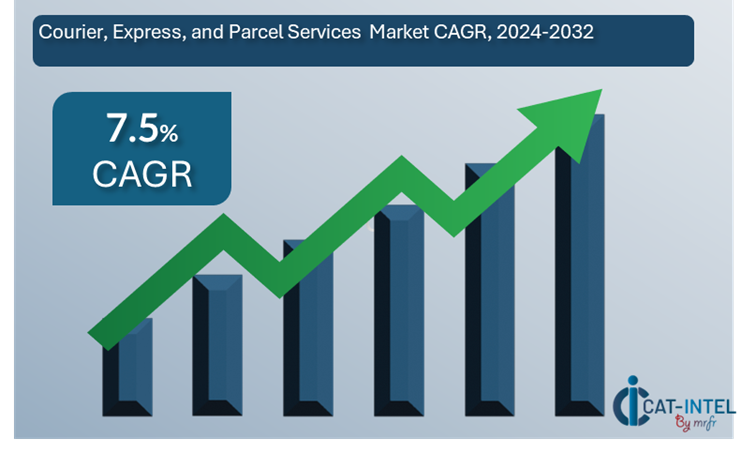
- Sector Contributions:
- E-commerce: The continued growth of online shopping is a major driver for the expansion of express delivery services, with a focus on same-day and next-day delivery options.
- International Trade: Cross-border shipping services are also a critical contributor, as global trade continues to grow and require more efficient delivery options.
- Technological Transformation and Innovations: The adoption of AI, machine learning, and automation in warehouse management and logistics systems is transforming the CEP sector. Additionally, the integration of real-time tracking systems and improved data analytics is allowing businesses to optimize delivery routes, reduce costs, and increase delivery speed.
- Funding Initiatives: Investment in sustainable delivery models, such as electric delivery vehicles and carbon-neutral shipping solutions, is on the rise. This is helping companies meet growing environmental expectations and reduce operational costs.
- Regional Insights: North America and Europe currently lead the CEP market, but rapid growth is expected in the Asia-Pacific region, driven by increased e-commerce penetration and a rising middle class in emerging markets.
Key Trends and Sustainability Outlook
- Sustainability Initiatives: Companies in the CEP market are increasingly adopting green logistics practices, including the use of electric vehicles, biodegradable packaging, and energy-efficient warehouses to reduce their environmental impact.
- E-commerce Growth: The continued growth of e-commerce, particularly in Asia and North America, is expanding the demand for CEP services, with a strong focus on last-mile delivery innovations and flexible delivery options.
- Technological Innovations: Advancements in tracking technologies, automation, and robotics are enhancing service reliability, reducing delivery times, and optimizing delivery operations.
Growth Drivers:
- E-commerce Expansion: As the global e-commerce sector continues to grow, the need for fast and reliable delivery services is driving the demand for CEP services.
- Globalization and Trade: Increased international trade and the need for efficient global shipping solutions are also fuelling market expansion.
- Digital Transformation: The integration of digital tools such as AI-powered route optimization and predictive analytics is enhancing operational efficiency and service delivery.
Overview of Market Intelligence Services for the Courier, Express, and Parcel Services Market
Recent analysis indicates that the Courier, Express, and Parcel Services market is being shaped by the need for speed, cost-effectiveness, and sustainability in delivery. Fluctuating fuel prices, rising labour costs, and the growing demand for environmental sustainability are driving both cost volatility and innovation within the market. By leveraging advanced market reports, businesses can gain insights into cost forecasting, supplier performance, and demand trends, helping them navigate uncertainties and optimize their procurement strategies.
Market intelligence services provide a comprehensive understanding of regional market dynamics, supplier landscape, pricing trends, and competitive strategies. These insights allow stakeholders to manage cost volatility, forecast demand accurately, and ensure access to reliable and efficient delivery partners. Strategic sourcing and procurement management in the CEP market are essential for building resilience in the supply chain, enhancing supplier relationships, and improving overall service delivery performance.
Procurement Intelligence for Courier, Express, and Parcel Services Market: Category Management and Strategic Sourcing
"To stay ahead in the Courier, Express, and Parcel Services (CEP) market, companies are optimizing procurement strategies by leveraging spend analysis solutions for vendor spend analysis and enhancing supply chain efficiency through comprehensive supply market intelligence. Effective category management and strategic sourcing are becoming increasingly critical in achieving cost-effective procurement, ensuring the timely availability of reliable and efficient delivery services for both domestic and international shipments."
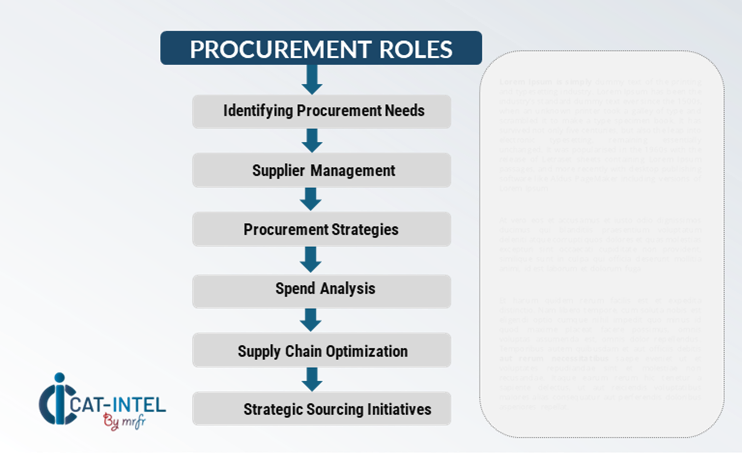
Pricing Outlook for Courier, Express, and Parcel Services (CEP) Market: Spend Analysis
The Courier, Express, and Parcel (CEP) services market is facing a dynamic pricing environment influenced by several key factors. These include rising fuel costs, labour shortages, increasing demand for faster delivery services, and the growth of e-commerce. These factors combine to create a volatile pricing landscape for delivery services, which has been further amplified by global supply chain disruptions.
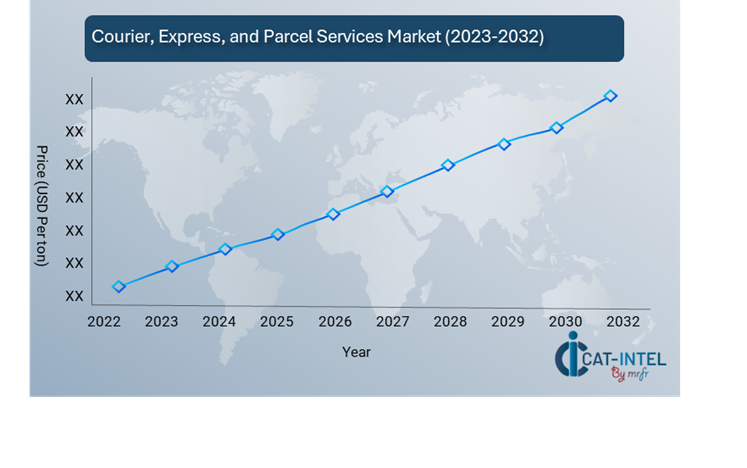
Key Factors Influencing Pricing Trends:
- Rising Operational Costs:
- Increased fuel prices, labour shortages, and infrastructure investment (e.g., fleet expansion, digital tools) are raising the overall cost structure for CEP providers. This is resulting in price hikes for consumers, particularly in international and express delivery services.
- Surge in E-commerce Demand:
- The rise of online shopping and the need for faster delivery services are putting pressure on CEP providers. E-commerce giants are demanding more rapid and cost-efficient delivery solutions, pushing service prices higher.
- Fuel Price Volatility:
- Fluctuating fuel prices significantly impact the operational costs of delivery services. As fuel is a major expense for transportation networks, it contributes directly to price volatility within the CEP market.
- Labor Shortages:
- The shortage of skilled labour, especially in delivery and logistics sectors, is leading to higher labour costs. Companies are facing increased wages to attract and retain delivery drivers and warehouse workers, contributing to rising service fees.
- Global Supply Chain Disruptions:
- The ongoing supply chain challenges, such as port congestion and transportation bottlenecks, affect the timely movement of goods, causing delays and driving up costs for urgent and express deliveries.
- Last-Mile Delivery Costs:
- The increasing demand for quick and convenient last-mile deliveries, particularly in urban areas, is driving higher costs. Providers must invest in new technologies and solutions to optimize last-mile delivery, which ultimately increases service prices.
Cost Breakdown for the Courier, Express, and Parcel (CEP) Services Market: Cost-Saving Opportunities

- Transportation Costs (40%)
- Description: Represents the cost of fuel, vehicle maintenance, and logistics management for last-mile and long-distance deliveries.
- Trends: Fluctuations in fuel prices and the adoption of fuel-efficient delivery vehicles are key drivers. Recent trends show a rise in fuel costs, impacting overall pricing.
- Labor Costs (XX%)
- Technology & Automation (XX%)
- Packaging Costs (XX%)
- Infrastructure & Overheads (XX%)
Cost-Saving Opportunity: Negotiation Levers and Purchasing Negotiation Strategies
In the Courier, Express, and Parcel (CEP) Services market, cost-saving opportunities can be achieved through several strategies. Collaborative purchasing and bulk discounts help reduce unit costs, while automation and AI-driven route optimization enhance efficiency and lower labour costs. Investing in energy-efficient operations and electric vehicles cuts utility and fuel expenses. Outsourcing logistics functions to third-party providers reduces infrastructure costs, and route optimization further minimizes transportation expenses. Additionally, dynamic pricing models and consolidated shipping improve revenue and reduce freight costs, allowing companies to maximize profitability while managing operational expenses effectively.

Supply and Demand Overview of the Courier, Express, and Parcel (CEP) Services Market: Demand-Supply Dynamics and Buyer Intelligence for Effective Supplier Relationship Management (SRM)
The CEP services market is evolving due to the surge in e-commerce, shifting consumer expectations, and advancements in technology. The demand for quick, reliable, and cost-effective delivery solutions has increased significantly, driven by online shopping trends, global trade, and rising consumer preferences for faster deliveries.
Demand Factors:
- E-Commerce Growth: The expanding e-commerce sector is a major driver of increased demand for CEP services, with more consumers opting for fast shipping and home deliveries.
- Consumer Expectations: The demand for quicker, more reliable deliveries is growing as consumers expect faster and more transparent tracking systems.
- Global Trade Expansion: International trade is fuelling demand for cross-border shipping services, increasing the need for efficient global delivery networks.
- Sustainability Focus: Consumers and businesses alike are increasingly prioritizing environmentally friendly shipping options, which is influencing demand for sustainable and carbon-neutral delivery services.
Supply Factors:
- Technological Advancements: Automation, AI, and route optimization technologies are helping CEP providers meet rising demand while improving efficiency and reducing operational costs.
- Infrastructure Expansion: Increased investments in logistics infrastructure, such as warehouses, sorting facilities, and delivery hubs, are improving supply capabilities.
- Last-Mile Delivery Innovations: The rise of alternative delivery solutions, such as drones and autonomous vehicles, is enhancing supply chains and addressing last-mile delivery challenges.
- Competitive Market: Increased competition among CEP providers drives improvements in service quality and pricing, influencing supply and availability of services.
Regional Demand-Supply Outlook: Courier, Express, and Parcel (CEP) Services Market
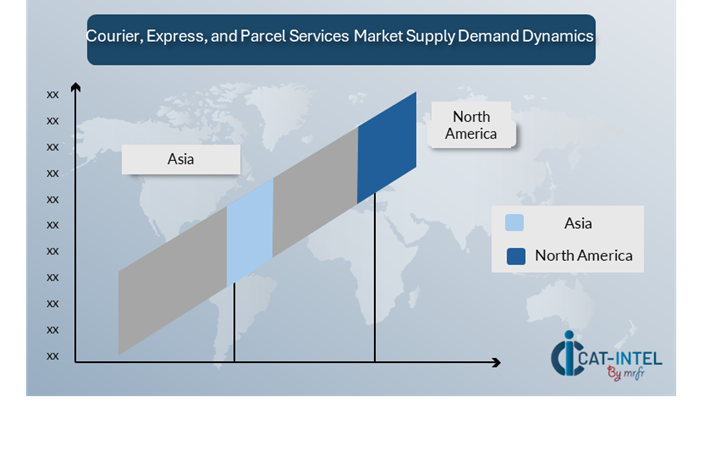
North America: A Key Player in the CEP Services Market
North America, particularly the U.S., plays a significant role in the global CEP services market, characterized by:
- Leading Providers: Major CEP companies like FedEx, UPS, and USPS dominate the U.S. market, offering extensive domestic and international services.
- E-Commerce Growth: The U.S. continues to lead in e-commerce growth, which drives demand for fast, reliable delivery services, especially for online retail and last-mile solutions.
- Technological Innovations: Advanced logistics technologies, including route optimization, automation, and AI, are driving supply chain efficiency and reducing delivery times across the region.
- Sustainability Initiatives: CEP providers in North America are increasingly focusing on reducing carbon footprints through electric vehicles, carbon-neutral shipping, and sustainable packaging solutions.
- Consumer Expectations: As consumer demand for faster, more transparent delivery services increases, U.S. CEP companies are focusing on improving speed, reliability, and tracking capabilities to meet these needs.
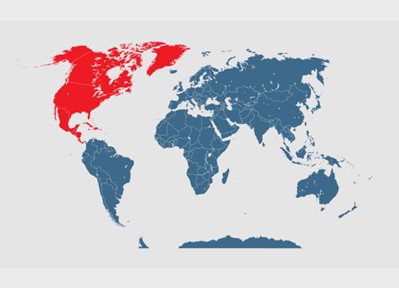
North America remains a key hub for courier, Express, and Parcel (CEP) Services Market and its growth
Supplier Landscape: Supplier Negotiations and Strategies for the Courier, Express, and Parcel (CEP) Services Market
The CEP services market is supported by a diverse range of suppliers that provide crucial services and infrastructure for efficient parcel delivery. Key suppliers in this landscape include logistics technology providers, fuel and fleet management companies, warehousing and packaging suppliers, as well as last-mile delivery partners. Collaboration between CEP providers and these suppliers is essential for maintaining delivery speed, reducing operational costs, and improving customer satisfaction.
Key suppliers in the CEP services market include:
- SAP (Logistics Software Solutions)
- Oracle (Supply Chain Management Solutions)
- DHL Supply Chain
- XPO Logistics
- Siemens (Automation and Robotics Solutions)
- C.H. Robinson
- Manhattan Associates (Warehouse Management Systems)
- FedEx Express (Internal Fleet and Delivery Services)
- UPS Supply Chain Solutions
- Ryder System, Inc. (Fleet Leasing and Logistics Solutions)

Key Development: Procurement Category significant development
Procurement Category | Key Development | Impact on the CEP Market |
Logistics and Fleet Management | Increasing adoption of electric and autonomous vehicles for delivery. | Reduces operational costs, enhances sustainability, and improves delivery speed. |
Technology and Automation | Advancements in AI, machine learning, and robotics for route optimization and warehouse management. | Improves operational efficiency, reduces human error, and speeds up processing and delivery. |
Packaging and Material Supply | Shift towards sustainable packaging materials to reduce environmental impact. | Meets growing consumer demand for eco-friendly practices and reduces packaging costs. |
Last-Mile Delivery Services | Growth of gig economy-based platforms for last-mile delivery solutions. | Increases flexibility in delivery options, reduces costs, and offers faster deliveries. |
Fuel and Energy Management | Rise in fuel efficiency measures, including hybrid and electric vehicle integration. | Lowers fuel costs and supports environmental sustainability. |
Procurement Attribute/Metric | Details |
Market Sizing | The global CEP market is projected to grow from USD 435 billion in 2023 to USD 530 billion by 2032, with a CAGR of 7.5%. |
Adoption of CEP Solutions | Growing demand for same-day and next-day delivery, alongside the adoption of digital platforms for real-time tracking and customer interaction. |
Top Strategies for 2024 | Focus on automation, sustainability in operations (electric vehicles, eco-friendly packaging), and expanding e-commerce partnerships. |
Automation in CEP Services | Over 30% of CEP companies are adopting robotics, AI-driven sorting systems, and automated warehouses to enhance operational efficiency. |
Procurement Challenges | Key challenges include rising fuel costs, regulatory complexities, labour shortages, and maintaining service quality with growing e-commerce demand. |
Key Suppliers | Major players include DHL, FedEx, UPS, TNT Express, and Aramex, focusing on global expansion, innovation, and customer service. |
Key Regions Covered | Major markets include North America, Europe, and Asia-Pacific, with significant demand from the U.S., China, and India. |
Market Drivers and Trends | Growth is driven by the rise in e-commerce, consumer demand for faster deliveries, technological advancements, and sustainability concerns. |
Frequently Asked Questions (FAQ):
Our procurement intelligence services provide a comprehensive analysis of global courier, express, and parcel service providers. We offer spend analysis, supplier performance evaluations, and market intelligence to help source reliable and cost-effective logistics services, ensuring the best suppliers and pricing.
We assist in evaluating the Total Cost of Ownership (TCO) for sourcing CEP services by factoring in transportation, storage, fuel, packaging, and handling costs. Our cost analysis services help you understand the long-term financial impact of your logistics operations.
We provide a detailed risk management framework that highlights potential supply chain disruptions, regulatory risks, and fuel price fluctuations. Our solutions help mitigate risks associated with logistics services and ensure consistent delivery performance.
Our Supplier Relationship Management (SRM) services guide you in strengthening relationships with courier service providers. We focus on improving collaboration, negotiating favourable terms, and ensuring service consistency while maintaining cost efficiency.
We provide an overview of procurement best practices for the CEP market, including supplier categorization, pricing strategies, contract management, and performance tracking. These practices help ensure efficient and strategic procurement decisions.
Digital transformation enhances procurement by incorporating automation, data analytics, and real-time tracking of logistics services. Our solutions help streamline operations, monitor supplier performance, and optimize procurement strategies for increased efficiency.
Our supplier performance management services help assess and monitor courier and express service providers based on delivery accuracy, speed, and customer service. Regular evaluations support better decision-making and reduce risks associated with logistics operations.
We offer insights into effective negotiation strategies, enabling you to secure better pricing, volume discounts, and flexible payment terms. Our market intelligence approach ensures you make data-driven, favourable negotiations.
We offer advanced market analysis tools that provide insights into global courier, express, and parcel trends, supplier market share, and price forecasts. This data helps you understand market conditions, identify opportunities, and make informed purchasing decisions.
Our procurement solutions include guidance on regulatory compliance in the CEP market. We help you navigate complex procurement processes, ensuring that all suppliers adhere to local and international logistics regulations, including safety and security standards.
We offer strategies to mitigate supply chain disruptions, including diversifying service providers, establishing contingency plans, and monitoring real-time market trends. Our insights help maintain smooth logistics operations despite challenges.
Through our supplier performance tracking tools, we monitor the performance of CEP service providers, assessing delivery timelines, customer feedback, and service reliability. These evaluations ensure continuous optimization of your logistics operations.
We assist in identifying CEP providers that adopt sustainable practices, such as using electric vehicles, reducing emissions, and utilizing eco-friendly packaging. Our services ensure your suppliers meet environmental and social responsibility standards.
Our pricing analysis services enable you to compare logistics costs across different providers and regions, ensuring you secure competitive rates. We analyse pricing trends and market dynamics to optimize your procurement strategy.
We provide in-depth market analysis, identifying opportunities such as e-commerce growth and emerging markets, along with risks like fluctuating fuel prices and regulatory changes. Our insights help you stay ahead of industry trends and mitigate potential procurement risks in the CEP services market.








